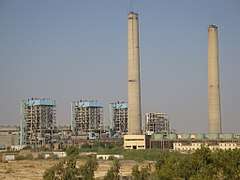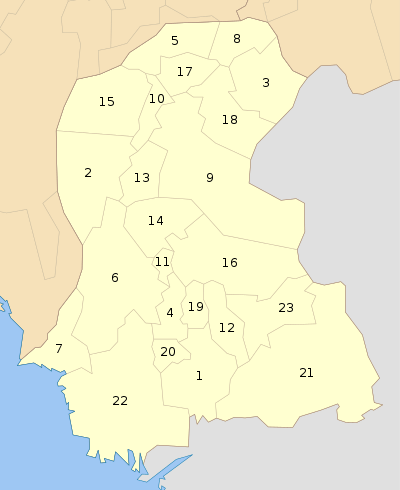Jamshoro District
Jamshoro District (Sindhi: ضلعو ڄام شورو, Urdu: ضِلع جامشورو), is a district of Sindh province, Pakistan. Jamshoro city is the capital of Jamshoro District.
Jamshoro District ضلعو ڄامشورو | |
|---|---|
 Map of Pakistani Districts with Jamshoro District highlighted | |
| Coordinates: 25.432512°N 68.263171°E | |
| Country | Pakistan |
| Province | Sindh |
| Headquarters | Jamshoro |
| Government | |
| • Chairman | Malik Shahnawaz Sikander |
| Population (2017)[1] | |
| • Total | 993,142 |
| Time zone | UTC+5 (PST) |
| Number of Tehsils | 5 |
| Website | www |

Jamshoro district was split from Dadu District in December 2004. It is situated on the west bank of River Indus. The district has taken its name from Jamshoro town which is also known as Educational City. However the District's headquarter is at Kotri.
Sindh Industrial AndTrading Estate
Two main town's of Sindh Industrial and Trading Estate are in Jamshoro District, Kotri and Nooriabad. Having more than 500 production plants which produces Cotton, Rice, Flour, Oil and many more.[2]
Boundaries
The district borders Dadu district to the north. To the east, the Indus separates it from Nawab Shah, Matyari and Hyderabad districts. Thatta district lies to the south, and Karachi district to the south west. To the west, the Kheerthar Range separates it from the Sindh and Lasbela district of Baluchistan.
Geography
The total geographical area of the district is 11,517 square kilometres. It is about 220 kilometers from north to south and about 100 kilometres wide from east to west. A 2 to 6 kilometres wide belt of the west bank of River Indus is cultivated and irrigated and the remaining land of the district is either hilly or cultivated. Agriculture is the main source of income. In summer, the northern part (Sehwan) is hotter than that of other parts of the district and normally cool in winter.
The district is rich in limestone, salika sand, gravels, silt, and marble. These minerals are found in Taluka Thano Bula Khan and Sehwan. Coal is obtained from Lakhra Taluka Manjhand.
Demographics
The population of the district according to a 2011 estimate was 1,176,969.[3] The predominant first language is Sindhi, which as of 1998 was spoken by 84% of the total population in the talukas of Kotri, Sehwan and Thano Bula Khan. Urdu accounted for 6.3%, Punjabi – for 4.2% and Pashto – for 3%.[4]
The current population figures are tabulated below[5]:
| Name | Status | Population
Census 1998 |
Population
census 2017 |
|---|---|---|---|
| Jamshoro | District | 582,094 | 993,142 |
| Kotri | Taluka | 207,574 | 437,561 |
| Manjhand | Taluka | 100,105 | 140,840 |
| Sehwan | Taluka | 170,589 | 279,291 |
| Thanu Bula | Taluka | 103,826 | 145,450 |
Economy
The majority of the population of the district is rural and they are involved in cultivation. Industrial areas and Power plants are using manpower, while towns are providing business opportunities to the residents. The inhabitants of mountainous area keep cattle while Mallahs o Manchhar Lake earn their living by fishing. Approximately 20% of the district population works for the federal and provincial government.
Nooriabad Industrial Area and Kotri Industrial area are two big zones of Industries where more than 500 different industries are located..

Jamshoro Power Station, Lakhra Power Project and Kotri Thermal Power Station are the main power units in this district.
Education
Mehran University of Engineering and Technology, Liaquat University of Medical and Health Sciences and University of Sindh are located in Jamshoro.
Administrative divisions
The district is administratively subdivided into the following talukas:
References
- "DISTRICT WISE CENSUS RESULTS CENSUS 2017" (PDF). www.pbscensus.gov.pk. Archived from the original (PDF) on 2017-08-29. Retrieved 2017-09-03.
- https://www.site.com.pk/wordpress/
- "Sindh population surges by 81.5 pc, households by 83.9 pc". Thenews.com.pk. 2 April 2012. Retrieved 2013-04-21.
- PCO 2000, pp. 109–11.
- "Pakistan: Tehsils and Talukas (Districts and Subdistricts) - Population Statistics, Charts and Map". www.citypopulation.de. Retrieved 2020-02-23.
Bibliography
- 1998 District census report of Dadu. Census publication. 82. Islamabad: Population Census Organization, Statistics Division, Government of Pakistan. 2000.
Kherthar national Park.
